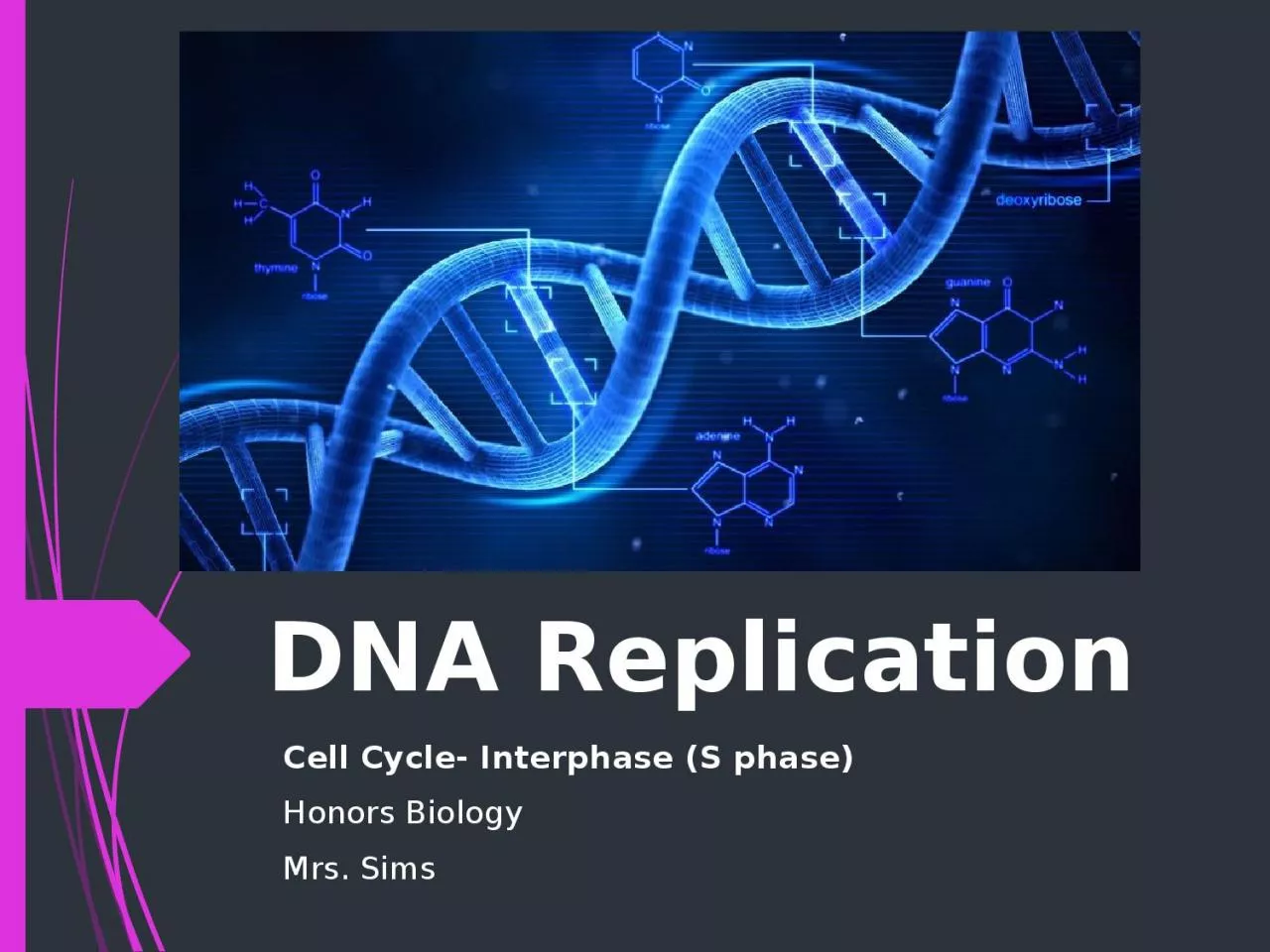

Honors Biology Mrs Sims Lets Start with a Video Please view the video before you start this presentation DNA Replication Animation This animation is created by McGraw Hill the publisher of your textbook ID: 920438
Download Presentation The PPT/PDF document "DNA Replication Cell Cycle- Interphase (..." is the property of its rightful owner. Permission is granted to download and print the materials on this web site for personal, non-commercial use only, and to display it on your personal computer provided you do not modify the materials and that you retain all copyright notices contained in the materials. By downloading content from our website, you accept the terms of this agreement.
Slide1
DNA Replication
Cell Cycle- Interphase (S phase)Honors BiologyMrs. Sims
Slide2Let’s Start with a Video
Please view the video before you start this presentation. DNA Replication Animation
**This animation is created by McGraw Hill, the publisher of your textbook.
Slide3Focus Questions
18) What does the ending –ase tell about a molecule?
19) In
which direction does DNA replicate?
20) Why
does one strand replicate faster and one slower?
Slide4Replication copies the genetic information.
A single strand of DNA serves as a template for a new strand.
The rules of base pairing
direct replication
.
DNA is replicated during
the S
(synthesis) stage of
the cell
cycle.
Each body cell gets a
complete set of
identical DNA.
Slide5Prokaryotes vs. Eukaryotes
Prokaryotes have ONE point of Origin on their circular chromosome Eukaryotes have MANY on their linear chromosomes!
Prokaryotes:
Eukaryotes:
Slide6Alternative Models of DNA Replication
Slide7Semiconservative
replication
Parental DNA
First generation
Second generation
Slide8Mutations
DNA Polymerase has an error rate of only 1 wrong nucleotide per 100,000!
Mutations
are any change in DNA sequence and can be caused by mutagen
A
mutagen
is any chemical or environmental condition that causes a mutation
Point Mutations
– mutations in a single nucleotide base
Substitution
– one nucleotide substituted for another
Insertion
– one nucleotide is inserted into the sequence
Deletion
– one nucleotide is deleted from the sequence
Slide9DNA Replication
1) DNA Helicase attaches to DNA and breaks the hydrogen bonds between bases to unwind it.
2)
Primase
puts down an RNA primer for DNA Polymerase to attach nucleotides to.
3)
DNA Polymerase III
adds nucleotides moving towards the 5’ end of the template strand building the new strand from the 5’ to 3’ direction.
Leading strand is continuous
Lagging Strand is slower, discontinuous and creates
Okazaki Fragments
4)
DNA Polymerase I
removes the RNA primers and replaces them with DNA nucleotides.5) Ligase
covalently bonds the replaced DNA nucleotides together.
Slide10DNA helix
RNA primer
DNA polymerase
Lagging strand (first
Okazaki fragment
)
Direction of replication
Replication
fork
(
Helicase
unwinding)
Leading strand
1
DNA
Helicase
attaches to DNA and breaks the hydrogen bonds between bases to unwind
it, creating a
Replication Fork
.
Primase
puts down an
RNA primer
for
DNA
Polymerase III
to attach nucleotides to
.
DNA Polymerase III
adds nucleotides moving towards the 5’ end of the strand it is
on, so it builds the new strand from the 5’ to 3’ direction.
Slide11Leading strand
Primase
:
makes RNA
primers
Two
Okazaki fragments
2
DNA Polymerase III
adds nucleotides to the Leading and Lagging strands as it moves towards the 5’ end of each strand it is using as a template. This creates
Okazaki Fragments
on the Lagging strand.
Slide124) DNA
Polymerase I
removes the
RNA primers
and replaces them with DNA nucleotides.
5) DNA Ligase
covalently bonds the replaced DNA nucleotides together.
3
Leading strand
DNA ligase
Third
Okazaki fragment
Lagging strand
DNA Polymerase I
RNA
primer (
P
rimase
)
Helicase
DNA Polymerase III
Slide13Focus Questions
21) What are the three ways in which DNA was hypothesized to replicate
? Which is the actual method?
22) What
scientists performed an experiment to determine the way in which DNA replicates?
23) What
are the two different strands involved in DNA replication and which strand is replicated faster
?
24) Why is there a difference between the replication rate of each strand? (
Describe in terms of replication direction and
continuity.)
Slide14DNA Replication in Real Time
https://www.youtube.com/watch?v=yqESR7E4b_8